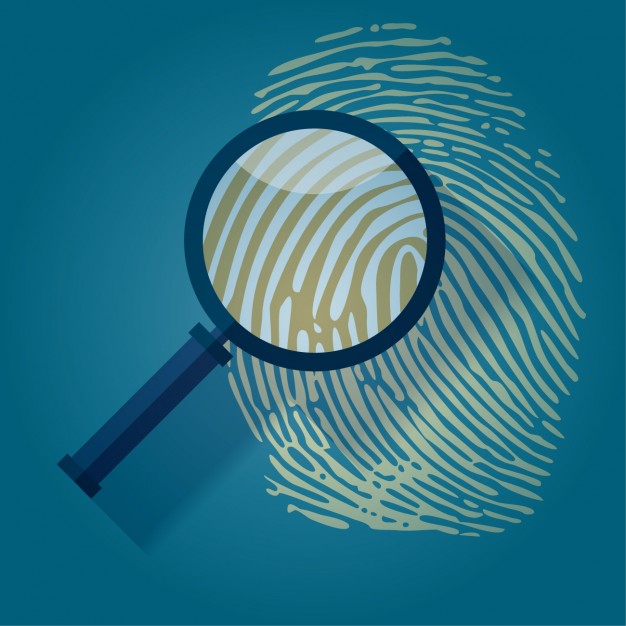Fingerprints Analysis
Fingerprints are patterns created by raised ridges and recessed furrows on a person’s fingers and thumbs. Everybody’s fingerprints are completely unique, and even identical twins (who share the same DNA) have different fingerprints. The prints on an individual’s palms and pads of their feet are also unique, but those are rarely used for identification purposes.
The pattern left when someone with ink on their finger touches a piece of paper shows the ridges of that individual’s fingerprint. There are three distinct types of friction ridge patterns – arches, loops, and whorls. Arches are a wave-like pattern.
There are two types of Arches:
plain and tented. Tented arches rise to a sharper point than plain arches. Arches make up about 5% of all fingerprint patterns.
Loops are ridges that curve back on themselves creating a loop-shaped pattern.
There are two types of loops:
radial and ulnar. Radial loops are pointed towards the radial bone or thumb.
Ulnar loops are pointed towards the ulnar bone or pinky finger. Loops make up about 60% of all fingerprint patterns. Then there are whorls. Whorls are spiral or circular patterns.
There are four types of whorls. Plain whorls are concentric circles. The central pocket loop is a whorl at the end of a loop. An accidental loop is irregular in shape.
A double loop creates an “S” like pattern. Whorls make up about 35% of all fingerprint patterns.
There are two premises of fingerprint identification:
permanence and uniqueness. Permanence is also known as persistence and is looked at because fingerprints essentially don’t change over a lifetime. The fingerprints you are born with are yours forever.
Even attempts at removing an individual’s fingerprint don’t work unless the damage is extremely deep because new skin grows back in the same ridges and furrows that have always been there. If the damage is extremely deep, the damage will cause the ridges and furrows to grow differently, and those new ridges and furrows will become permanent.
With no two people ever having been found to have the same fingerprint, and no two fingers on the same person having the same fingerprint pattern, they are all unique.
When analyzing fingerprints, the general pattern type – whether it be loops, whorls, or arches – is used for the initial comparison.
This is done to include or exclude a known print from that of an unknown print. When matching a print, the analyst uses the minutiae or ridge patterns to compare specific points of the fingerprint to determine if it matches the print they are looking for.
This is done when trying to identify an unknown print. After careful analysis, the computer or analyst can determine if the print is a match or not, and if it’s not a match go on to compare the print to the next known sample. Years ago this was all done by hand, with an analyst that would spend all of their time just trying to identify or match fingerprints using a loupe, but thanks to technology, a computer does that now.
There are many uses for fingerprint identification. Fingerprints can be used for background checks, weapons permits, employment, and security clearance.
They can also be used to identify amnesia victims, and for biometric security. In criminal justice, fingerprints are extremely important since everything we have ever touched has left behind our fingerprints. The prints found at a crime scene are collected and used to identify victims, separate the suspect’s prints from other people in the area, and finally, to identify who the suspect is. Those prints can also link the suspect to other unsolved crimes.
Related Post: Why You Need to do Employment Background Checks?
Fingerprint examiners use a method called ACE-V to make a determination of each fingerprint. ACE-V stands for Analysis, Comparison, Evaluation, and Verification. The Analysis is determining if a print is suitable for comparison. If the print quality or clarity is not suitable, they stop there with that print and move on to the next one. If the print is suitable, they move on to comparison, which is when they view known and suspect prints side-by-side. During the evaluation, they determine if the prints are from the same source. Then they begin the verification, where they have another examiner go through the process to see if their analysis supports the first examiner’s conclusion. If the conclusion is supported and the prints match, they can then use the prints as part of the criminal case against the suspect.
Please visit us at CertifixLiveScan.com to find your nearest location, or give us a call at 1-800-710-1934, or email us at support@certifixlivescan.com.
Read more about: What are the Safest Ways to Complete Your Live Scan during the Covid-19 Pandemic?
Image Credit: Glass vector created by alvaro_cabrera – www.freepik.com
Was This Helpful?
Enjoy this article? Don't forget to share.
Frequently Asked Questions
-
Is live scan the same as fingerprinting?
Live scan is fingerprinting done electronically performed for an agency or an individual to receive a background check from the DOJ and FBI.
-
Can I roll my own fingerprints for the certification?
No, another certified fingerprint roller must process a Live Scan transaction on you.
-
How do I get a Fingerprint Roller Certificate?
1-Review the Handbook -this handbook provides you with basic steps and responsibilities for obtaining a Certification, including background check information and disqualifying offenses.
2-Complete the Application for Certification (Form BCIA 8372), Learn More. -
What are the fees for certification to be a fingerprint roller?
The total fee required by the Department of Justice for certification is $74.
This fee does not include the rolling fee.

